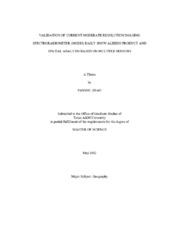| dc.description.abstract | Snow albedo is one of the most important factors for atmosphere-surface energy exchange in high latitude areas. Remote sensing provides continual observations of snow albedo. However, the reliability of snow albedos obtained from remotely sensed images can be problematic, especially when acquired over heterogeneous land surfaces.
This research examines spatial variations in snow albedo observed under different conditions in order to assess how accurate an individual in situ observation of snow albedo is when compared to the Moderate Resolution Imaging Spectroradiometer (MODIS) daily snow albedo product (MOD10A1) and its relationship with land surface types. In addition to the field observations, albedos retrieved from two SURFRAD stations are also examined. The overall Root Mean Square Error (RMSE) between the in situ and MODIS albedos is 8%.
Semivariogram analysis of Landsat ETM+ snow albedo retrievals on January 26th, 2010 over an ice and snow covered lake indicates spatial autocorrelation lengths of approximately 260 m, suggesting limited in situ observation can be considered fairly representative of albedos retrieved from MODIS images. To further reveal what parameters could influence the spatial representativeness, this research examined landscape metrics based on seven binary snow maps created from Landsat images for three areas of differing roughness and for different snow cover conditions. There are two Landscape metrics, Mean Shape Index (MSI) and Area Weighted Shape Index (AWMSI), were found to be correlated the spatial autocorrelation lengths of snow albedo as measured from the range distance of the modeled semivariograms.
In addition, this research also introduced a method of using multi-angle mast to measure the surface bidirectional reflectance distribution function (BRDF). This method could be used for further research to build the BRDF library of the snow-covered canopies. | en |


